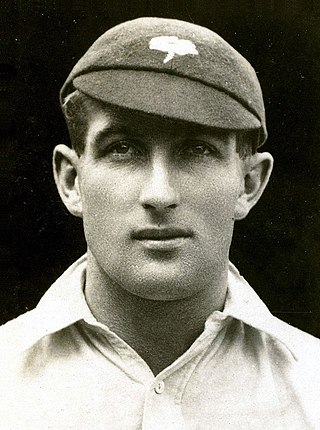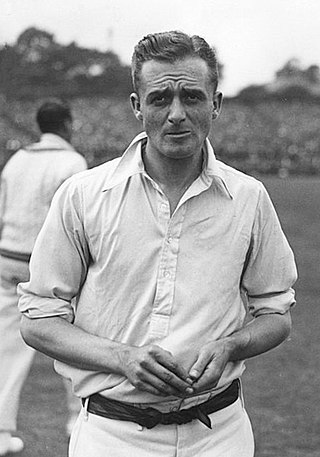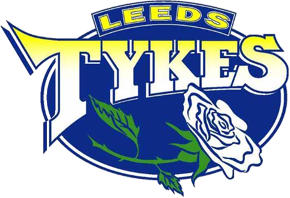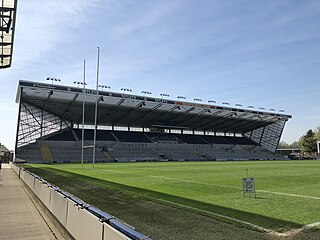Related Research Articles

The Fartown Ground or just simply Fartown is a sports ground located in the Huddersfield suburb of Fartown in West Yorkshire, England and is predominantly famous for being the home ground of Huddersfield Rugby League Club from 1878 to 1992. The grounds consisted of a rugby ground, a cricket ground used by Yorkshire County Cricket Club, Bowling greens and a running track as well as a pavilion. It was the scene of many great games, including the Challenge Cup finals of 1908 and 1910, several Challenge Cup semi finals, John Player Cup finals and international matches.

Elland Road is a football stadium in Beeston, Leeds, West Yorkshire, England, which has been the home of Championship club Leeds United since the club's formation in 1919. The stadium is the 14th largest football stadium in England.

Yorkshire County Cricket Club is one of eighteen first-class county clubs within the domestic cricket structure of England and Wales. It represents the historic county of Yorkshire. Yorkshire's first team is the most successful in English cricketing history with 33 County Championship titles, including one shared. The team's most recent Championship title was in 2015. The club's limited overs team is called the Yorkshire Vikings and their kit colours are Cambridge blue, Oxford blue, and yellow.

Abraham "Abe" Waddington, sometimes known as Abram Waddington, was a professional cricketer for Yorkshire, who played in two Test matches for England, both against Australia in 1920–21. Between 1919 and 1927 Waddington made 255 appearances for Yorkshire, and in all first-class cricket played 266 matches. In these games, he took a total of 852 wickets with his left arm fast-medium bowling. Capable of making the ball swing, Waddington was admired for the aesthetic quality of his bowling action. He was a hostile bowler who sometimes sledged opposing batsmen and questioned umpires' decisions, behaviour which was unusual during his playing days.

George Gibson Macaulay was a professional English cricketer who played first-class cricket for Yorkshire County Cricket Club between 1920 and 1935. He played in eight Test matches for England from 1923 to 1933, achieving the rare feat of taking a wicket with his first ball in Test cricket. One of the five Wisden Cricketers of the Year in 1924, he took 1,838 first-class wickets at an average of 17.64 including four hat-tricks.
The Sheffield Cricket Club was founded in the 18th century and soon began to play a key role in the development of cricket in northern England. It was the direct forerunner of Yorkshire County Cricket Club and some of the teams fielded by Sheffield were styled Yorkshire. Sheffield generally held first-class status, depending on the quality of their opponents, from 1827 to 1855.

John "Jack" Crossland was an English professional cricketer who played first-class cricket between 1878 and 1887. Crossland was recognised as one of the fastest bowlers in county cricket, but critics generally believed that he threw, rather than bowled the ball, a practice illegal in cricket. Contemporaries suggest that, but for the suspicions over his bowling action, Crossland would have played Test cricket for England.
John Thewlis was an English first-class cricketer, active 1862–75, who played for Sheffield and Yorkshire. Thewlis was noted as a right-hand batsman with a full range of strokes.

Leeds Tykes is an English rugby union club in Leeds, West Yorkshire, England, playing in the National League 2 North.
Fulfordgate was an association football ground in Fulford, York, England, and was the home of York City Football Club from 1922 to 1932. The ground was located next to Heslington Lane, and was purchased by York for £2,000 following their formation in 1922.
Woodhouse Hill was a stadium in the Hunslet district of Leeds which was used for cricket and rugby football.
Peter John Hampton was an English footballer who played as a left back in the Football League for Leeds United, Stoke City, Burnley, Rochdale and Carlisle United.
The United South of England Eleven (USEE) was an itinerant cricket team founded in November 1864 by Edgar Willsher, as secretary, and John Lillywhite, as treasurer. The USEE had no home venue as its prime purpose, like all similarly named teams of the time, was to operate as a travelling show and bring top-class cricket to places in Great Britain and Ireland which rarely received it. Fourteen USEE matches have been recognised by CricketArchive as first-class, mostly against the rival United North of England Eleven (UNEE). The USEE is estimated to have played 217 "odds" matches as a visiting team against local club sides which generally used 22 players.
Derbyshire County Cricket Club in 1874 was the cricket season when the English club Derbyshire earned the title of Champion County in their fourth year playing as a club. Kent joined Lancashire to make the second County side to play first class matches against Derbyshire in 1874. Derbyshire won three first-class matches and drew one, making it the only season in which they never lost a match.
Portrack Lane was a cricket ground in Stockton-on-Tees, Durham. The first recorded match on the ground was in 1839, when Stockton played an All-England Eleven. The ground also hosted two first-class matches, the first of which was in 1858 when a combined Yorkshire and Durham team played Nottinghamshire. The second and final first-class match to be played on the ground came in 1861, when Yorkshire with Stockton-on-Tees played Cambridgeshire.
Broughton Cricket Club Ground is a cricket ground in Broughton, Salford, Greater Manchester. The first recorded match on the ground was in 1851, when Broughton played an All-England Eleven.

Headingley Rugby Stadium shares the same site as Headingley Cricket Ground and is home to Leeds Rhinos. Headingley is the 5th largest rugby league stadium in England.

Headingley Cricket Ground is a cricket ground in the Headingley Stadium complex in Headingley, Leeds, England. It adjoins the Headingley Rugby Stadium through a shared main stand, although the main entrance to the cricket ground is at the opposite Kirkstall Lane end. It has hosted Test cricket since 1899 and has a capacity of 18,350.

Weetwood Playing Fields is a sports facility of the University of Leeds located in the Leeds suburb of Weetwood, West Yorkshire, England.
In English cricket, the years 1846–1863 were the main period of the sport's "roundarm era". Although roundarm had been legalised amid great controversy, its timespan was relatively short. By 1863, there was an increasing demand for the legalisation of overarm bowling and this was achieved on 10 June 1864.
References
- ↑ Other matches played on Victoria Ground (subscription required)
- ↑ First-Class Matches played on Victoria Ground (subscription required)